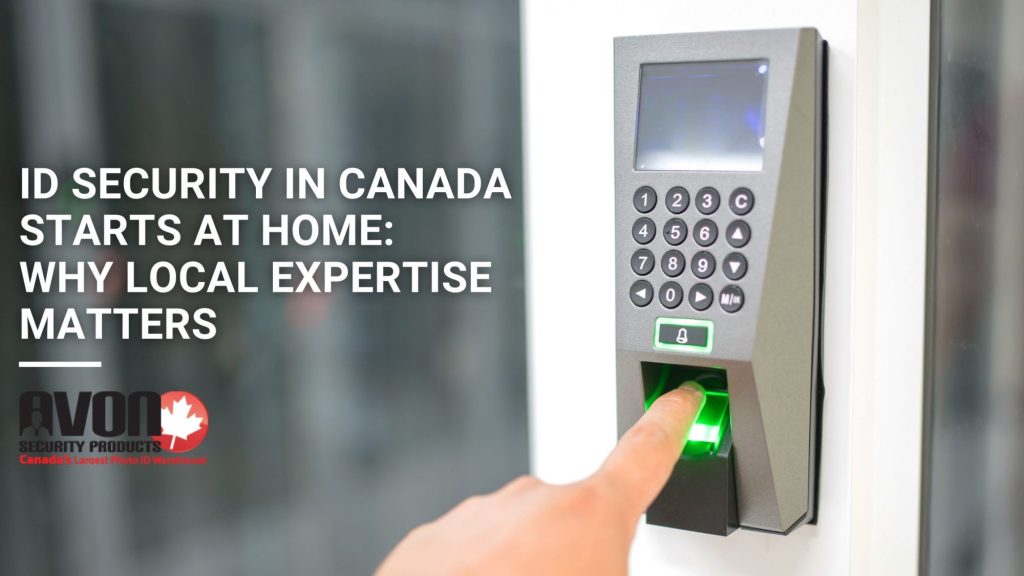Not all ID systems are created equal, and neither are the companies behind them. In a time when secure identification is critical for safety, compliance, and everyday operations, choosing a partner who understands the landscape isn’t just a nice-to-have. It’s essential.
That’s where local expertise makes all the difference.
Whether you’re managing access in a hospital, issuing staff credentials in a school, or keeping tabs on facility visitors, the ID tools you rely on need to work flawlessly and fast. But there’s more to it than printing cards. You need service without border delays, compliance without confusion, and support without overseas wait times.
For Canadian organizations, that smarter, more dependable choice starts with Avon Security Products, a company built right here at home, with a deep understanding of Canadian industries, regulations, and expectations.
Made in Canada, Built for Canada
Avon Security Products is proudly Canadian, with deep roots in the institutions that keep this country moving, schools, hospitals, government agencies, and businesses from coast to coast. That national footprint gives Avon Security Products a unique edge: they understand Canadian compliance standards, bilingual labelling requirements, and regional logistics better than anyone else.
While overseas providers can feel distant and generic, Avon Security Products’ team is local, responsive, and ready. You’re not submitting tickets into a void, you’re talking to a real person who understands your industry, your province, and your urgency.
Faster Shipping. No Customs. Zero Surprises.
When you’re ordering security tools, timing is everything. A delay of even a few days could disrupt onboarding, compliance audits, or frontline operations.
That’s where local inventory gives Avon Security Products a serious advantage.
Unlike international suppliers, there’s no waiting on customs clearance, no hidden import fees, and no unexpected delays. Avon Security Products ships directly from Canadian warehouses, with in-stock items often arriving within days, not weeks. That speed matters, especially for growing organizations that can’t afford downtime.
Trusted by Canada’s Most Secure Institutions
Why do so many top-tier Canadian organizations trust Avon Security Products? Because when identification is mission-critical, experience counts. Avon Security Products is a proven partner for:
- Public and private schools, ensuring safe, professional ID for staff and students
- Hospitals and clinics, where access control and patient data protection are non-negotiable
- Municipal, provincial, and federal agencies, requiring fully compliant and tamper-resistant solutions
In fact, Avon Security Products is known as Canada’s most trusted ID system supplier, not only for our robust technology but also for the peace of mind that comes with local service and support.
Identity verification in Canada isn’t just a formality, it’s a legal requirement. According to FINTRAC’s identity verification guidelines, organizations must follow strict procedures using government-issued ID or credit file verification methods to meet national compliance standards. Avon Security Products ensures its solutions support this level of security, helping Canadian institutions stay compliant while protecting what matters.
Smarter Support Starts at Home
Technical hiccups happen. The difference is what happens next.
Avon Security Products offers expert Canadian-based support, so when something goes wrong, or you just need guidance, you’re talking to someone who knows the product and your context. From warranty service to installation troubleshooting to upgrade advice, it’s all handled in-house, right here in Canada.
That means faster resolutions, no language barriers, and service that reflects the urgency of real-world operations.
Small Details, Big Protection
Strong security isn’t just about the printer. It’s about the entire ecosystem that supports your ID card strategy.
Our full range of card accessories and protection products, from badge holders to RFID-shielding sleeves, ensures your cards stay clean, readable, and secure. Whether you’re managing access to a secure facility or simply trying to extend the life of high-use credentials, these small details make a big difference in operational efficiency.
Built to Perform, Designed to Last
Our lineup of ID badge printers features the latest in ID card printers and printing technology, from compact desktop units for small offices to robust, high-capacity systems for enterprise use.
Designed for reliability and low maintenance, these printers support advanced encoding options, crisp photo resolution, and secure printing features like holographic overlays. For any Canadian business where ID matters, these are the tools that keep operations moving safely.
Customized Identification for Every Industry
Every industry has its own set of ID challenges, and Avon Security Products rises to meet them. Our lineup of identification solutions and products includes everything from proximity cards and fobs to tamper-proof visitor passes.
Need something tailored? With photo ID software and customization tools, you can build branded templates, manage user permissions, and integrate seamlessly with your existing systems. It’s about creating a solution that works your way.
High-security environments in Canada already rely on advanced ID systems. For example, the Restricted Area Identity Card (RAIC) program, led by CATSA and Transport Canada, uses biometric credentials like iris and fingerprint scans to manage access to secure airport zones. It’s a clear example of how Canada-specific identification solutions are designed for precision, compliance, and local operational needs, the same priorities Avon builds into every ID system it delivers.
Local Matters More Than Ever
In a world flooded with imported products and off-shore service centers, choosing a Canadian-made solution is a strategic investment. Avon Security Products doesn’t just ship faster. They serve smarter, support stronger, and stand by what they sell, with the kind of reliability only a local expert can offer.
If your organization is serious about security, don’t look overseas. Look homeward.
Discover how ID card systems designed for Canada, and supported by Canadians, can transform your workflow today.

